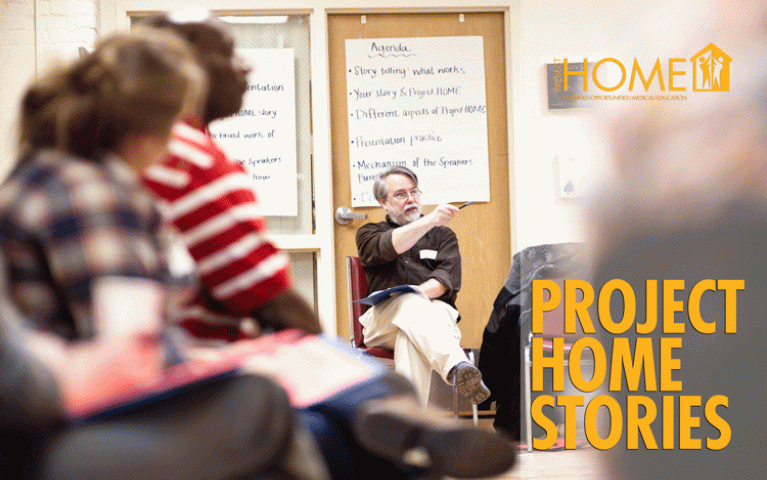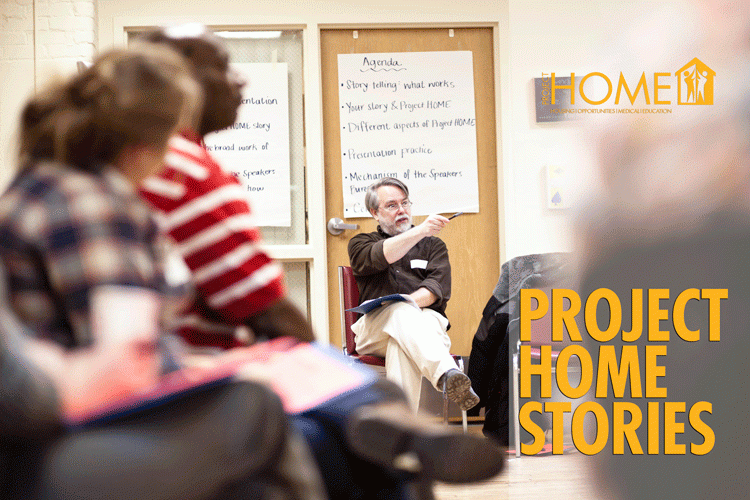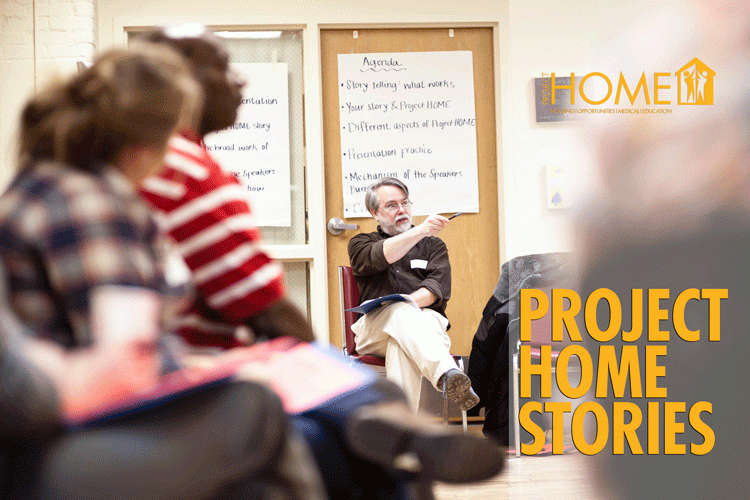Lights in the Darkness

Kim Covello is a volunteer for Project HOME who previously blogged about her experience doing street outreach with Sam Santiago of our Outreach Coordination Center.
...
It was Sunday, May 15, and I was driving from my Main Line home into Center City Philadelphia, excited and a little nervous. I am a 52-year-old retired attorney and suburban mom. I model for QVC and local commercials part-time and am really into health and fitness.
I had pulled my hair back into a ponytail, put on my jeans and sneaks, and picked up four Villanova University students, and was now heading to Broad Street Ministry for three hours of training that would equip us to head out to the streets with over 200 other volunteers in the wee hours of the morning. I was volunteering with an initiative called the 100,000 Homes Campaign, a national grassroots effort to place America’s most vulnerable, long-term homeless individuals into 100,000 homes by July 2013.
Philadelphia’s participation in the campaign was beginning with a week-long effort of surveying persons who are homeless on the streets. I was happy to have the company of the students from Villanova. They had just finished their final exams and had that drawn-out, exhausted look of too many all-nighters in the library. I was touched by their volunteerism. We arrived at the Ministry that Sunday afternoon, found our teams amongst the crowd of volunteers and settled in for the three-hour training session. Each team was assigned to a specific area of the city and once there, our goal was to survey as many homeless people as we could in two hours, to find out who were the most “vulnerable.”
The most “vulnerable,” we found out, were those people “most likely to die on the streets within a year, if they didn’t receive help.” Once identified, then the City Support Services would have the necessary information to follow up with the individuals surveyed and offer help. So we looked over the Survey. It contained bullet-type direct questions about the living situation, physical and mental health, and incarceration and military history of the individuals.
We received sheets of instructions, including the “Do’s and Don’ts of Surveying” and “Outline of Surveying Shift” which included the requirement that we “Report to the Ministry on Monday, Tuesday and Wednesday mornings no later than 4 am!” (No emphasis added) So a few minutes before 4 am on Monday morning, I greeted Carol Thomas, our team leader. She and I acknowledged that we knew each other from somewhere…but we come from different worlds, so from where…? It didn’t matter really, I had an instant affinity for Carol.
I’m sure she felt like swatting me away at times, but she was so “hip” and gently respectful at the same time. I felt lucky to be part of her team, so I stuck by her side and followed her everywhere. I learned so much from her about engaging people on the street. That first morning, our team climbed into the van and headed to University City, the area around Penn and Drexel. The streets were dark, chilly, wet with rain, and eerily quiet. Then we saw him, a dark blur seated under cover of a bus stop. Carol, sitting in the front passenger seat, hopped out. I followed her with my clipboard, holding the survey.
His name was Markus; he was sleeping in his wheelchair. Carol gently woke him, and he spoke to us in slurred tones at first. I squatted in front of his chair, looking up at him, and began asking the questions on the survey. Markus was a daily heroin user and had been on the streets for ten years. This past winter, he lost the toes on his right foot to frostbite. He told us he spent five days in the hospital when that happened, and then was released to the streets. At first, his parka hood covered most of his face but as we conversed, he started to pull the hood back a little, a small welcome sign into his world. I could see that Markus was a handsome man. Even Carol agreed that he was “nice looking.”
After that meeting, Carol and I knew that Markus was most “vulnerable” and needed help to get off the street ASAP. As part of the survey, we would request a picture so that we could better identify our people and go back out and find them. Markus answered all of our questions honestly but bristled when I asked to take his picture. In the end, he refused. We pushed it as far as we could, but gave him his $5 Wawa card and slowly left him. As I turned my back on this man, in a wheelchair in the dark, rainy bus stop, I felt hollowness in my heart…but Carol said it was a good interview, where we got important information. I felt motivated to find more people and do more surveys.
We continued on, in the darkness. The rain didn’t help our efforts. We circled the corner where the Green Grocer and the McDonalds are located. Members of our team noticed a man with a hoody pulled over his head, slumped in a small booth in McDonalds. The van parked and we all jumped out, pairing up and heading out in different directions. Team members Jasmin and Keesha left to interview the man in McDonalds and I followed Carol over to the Green Grocer. After talking with an African-American man in front of the store, Carol grabbed me and we headed over to his red truck to interview his girlfriend. It was really raining now and my survey papers were getting soaked. So Carol graciously asked if I could sit in the truck with Doris, the girlfriend.
I looked at Carol bug-eyed, but she just smiled at me, so I climbed in confidently next to Doris. Doris and her man were obviously living out of this truck for quite some time. There was no available space to place my feet, so I just rested them on the trash heaps on the floor. I ignored my surroundings and began “So Doris, how long have you been homeless?” We learned that Doris and her man were kicked out of their rooming house not too long ago and that they had no money left because the landlord kept the rent after kicking them out. Doris spoke so fast and eloquently that I was only a little surprised to learn that she had a post-graduate degree. But after the interview, I asked Carol, “What went wrong there? Doris was not a substance abuser and was an educated woman…?”
Carol surmised that Doris had some mental health issues that she did not admit to us. Driving rain greeted us the next morning, which meant it would be even harder to find people who needed help. We drove around for an hour squinting our eyes against the foggy wet view out the van window. We parked near a Wawa, and Carol and I plopped ourselves down on the pavement next to an African American woman who was groaning and prostrate on the ground. She said she was cold and started to get up and walk away from us. Her clothes were filthy and she was in dire need of immediate care, so Carol called for outreach services.
Chris from Outreach arrived within minutes and began talking to her, trying to see what services were needed immediately. She told us over and over about her boyfriend who had died. She said she had been on the streets for 23 years and she looked like that was the truth. We pulled away in the van as we saw Chris escort her to the car. We all breathed a sigh of relief, in the belief that she would get some respite at least for one night… As the dark night yielded to some light of the day, we saw a woman standing alone in the center of a vacant lot, in the rain.
Again, I followed Carol out of the van with my clipboard. Stephanie’s only protection against the rain was a little blue sweatshirt, so I pulled an umbrella from my bag and held it over her as Carol spoke. Stephanie was suffering from alcohol withdrawal, shaking from head to toe. She was a 45-year-old white woman who had graduated from a Catholic high school. Stephanie was in the throes of a psychotic episode and in between her ramblings about “the rats eating the dogs and then the cats,” she returned to reality and answered our questions clearly. When she spoke to us, she looked through us with the most amazingly beautiful blue eyes…
Carol and I were relieved when Stephanie agreed to go to the emergency room of the closest hospital. When Carol tried to direct us to a shortcut to Presbyterian Hospital’s ER, Stephanie refused and stayed the course on the sidewalk – she knew where she was going, despite her condition. We no sooner checked her into admissions than they were calling her name to take her away. But Stephanie has remained with me; she has been my companion in my thoughts and in my soul, since that night…she drives me with the desire to do more…more stories, more outreach, just more…

